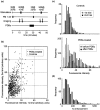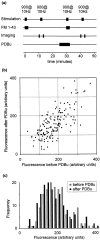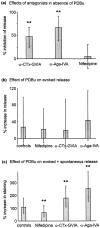Phorbol esters potentiate evoked and spontaneous release by different presynaptic mechanisms
- PMID: 11050105
- PMCID: PMC6772716
- DOI: 10.1523/JNEUROSCI.20-21-07863.2000
Phorbol esters potentiate evoked and spontaneous release by different presynaptic mechanisms
Abstract
Phorbol esters enhance release from a variety of cell types. The mechanism by which phorbol esters potentiate presynaptic release from central neurons is unclear, although effects of phorbol esters both on the readily releasable pool of vesicles and on presynaptic calcium channels have been shown. Using confocal microscopy and the fluorescent styryl dye FM 1-43, we have examined the effects of phorbol-12,13-dibutyrate (PDBu) on presynaptic vesicle turnover at individually identified synapses in dissociated cultures obtained from neonatal rat hippocampus. Using different dye staining and destaining protocols we were able to resolve two effects of PDBu. Potentiation of evoked release by PDBu was insensitive to calcium channel antagonists, suggesting that this effect results from an increased number of vesicles in the readily releasable pool. Since we observed no effect of PDBu on the size of the total recycling vesicle pool, we conclude that phorbol esters alter the equilibrium between reserve and readily releasable pools. An additional effect of PDBu on spontaneous release was observed. This effect was antagonized by nifedipine but not omega-conotoxin GVIA or omega-agatoxin IVA. We conclude that PDBu influences spontaneous and evoked release by two different mechanisms: through L-type calcium channels and through an increase in the proportion of recycling vesicles in the readily releasable pool. In addition to further clarifying the mechanism of action of phorbol esters, these results suggest that phorbol esters may be a useful tool with which to probe the function of the readily releasable pool of presynaptic vesicles at CNS synapses.
Figures







Similar articles
-
Dominance of P/Q-type calcium channels in depolarization-induced presynaptic FM dye release in cultured hippocampal neurons.Neuroscience. 2013 Dec 3;253:330-40. doi: 10.1016/j.neuroscience.2013.08.052. Epub 2013 Sep 5. Neuroscience. 2013. PMID: 24012836 Free PMC article.
-
Development of vesicle pools during maturation of hippocampal synapses.J Neurosci. 2002 Feb 1;22(3):654-65. doi: 10.1523/JNEUROSCI.22-03-00654.2002. J Neurosci. 2002. PMID: 11826095 Free PMC article.
-
Vesicle pool partitioning influences presynaptic diversity and weighting in rat hippocampal synapses.J Physiol. 2002 Jun 15;541(Pt 3):811-23. doi: 10.1113/jphysiol.2001.013485. J Physiol. 2002. PMID: 12068042 Free PMC article.
-
The synaptic vesicle cycle revisited.Neuron. 2000 Nov;28(2):317-20. doi: 10.1016/s0896-6273(00)00109-4. Neuron. 2000. PMID: 11144340 Review. No abstract available.
-
The molecular architecture of ribbon presynaptic terminals.Mol Neurobiol. 2009 Apr;39(2):130-48. doi: 10.1007/s12035-009-8058-z. Epub 2009 Mar 3. Mol Neurobiol. 2009. PMID: 19253034 Free PMC article. Review.
Cited by
-
Phorbol esters target the activity-dependent recycling pool and spare spontaneous vesicle recycling.J Neurosci. 2005 Nov 23;25(47):10922-9. doi: 10.1523/JNEUROSCI.3766-05.2005. J Neurosci. 2005. PMID: 16306405 Free PMC article.
-
A highly Ca2+-sensitive pool of vesicles is regulated by protein kinase C in adrenal chromaffin cells.Proc Natl Acad Sci U S A. 2002 Dec 24;99(26):17060-5. doi: 10.1073/pnas.242624699. Epub 2002 Nov 21. Proc Natl Acad Sci U S A. 2002. PMID: 12446844 Free PMC article.
-
Application of an Epac activator enhances neurotransmitter release at excitatory central synapses.J Neurosci. 2008 Aug 6;28(32):7991-8002. doi: 10.1523/JNEUROSCI.0268-08.2008. J Neurosci. 2008. PMID: 18685024 Free PMC article.
-
Presynaptic UNC-31 (CAPS) is required to activate the G alpha(s) pathway of the Caenorhabditis elegans synaptic signaling network.Genetics. 2006 Feb;172(2):943-61. doi: 10.1534/genetics.105.049577. Epub 2005 Nov 4. Genetics. 2006. PMID: 16272411 Free PMC article.
-
Dynamic modulation of phasic and asynchronous glutamate release in hippocampal synapses.J Neurophysiol. 2010 Jan;103(1):392-401. doi: 10.1152/jn.00683.2009. Epub 2009 Nov 4. J Neurophysiol. 2010. PMID: 19889850 Free PMC article.
References
-
- Augustin I, Rosenmund C, Südhof TC, Brose N. Munc 13-1 is essential for fusion competence of glutamatergic synaptic vesicles. Nature. 1999;400:457–461. - PubMed
-
- Betz WJ, Bewick GS. Optical analysis of synaptic vesicle recycling at the frog neuromuscular junction. Science. 1992;255:200–203. - PubMed
-
- Betz WJ, Mao F, Smith CB. Imaging exocytosis and endocytosis. Curr Opin Neurobiol. 1996;6:365–371. - PubMed
-
- Betz A, Ashery U, Rickmann M, Augustin I, Neher E, Südhof TC, Rettig J, Brose N. Munc 13-1 is a presynaptic phorbol ester receptor that enhances neurotransmitter release. Neuron. 1998;21:123–136. - PubMed
Publication types
MeSH terms
Substances
Grants and funding
LinkOut - more resources
Full Text Sources
